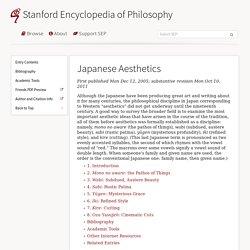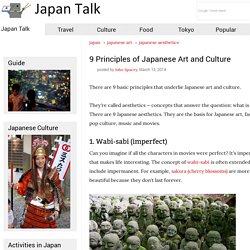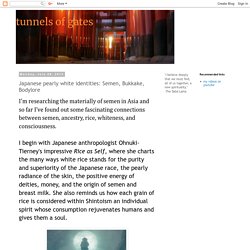

Japanese aesthetics. Japanophile. Japanese Aesthetics. 1.

Introduction Two preliminary observations about the Japanese cultural tradition to begin with. The first is that classical Japanese philosophy understands the basic reality as constant change, or (to use a Buddhist expression) impermanence. The world of flux that presents itself to our senses is the only reality: there is no conception of some stable “Platonic” realm above or behind it. The arts in Japan have traditionally reflected this fundamental impermanence—sometimes lamenting but more often celebrating it. It does not matter how young or strong you may be, the hour of death comes sooner than you expect. In the Japanese Buddhist tradition, awareness of the fundamental condition of existence is no cause for nihilistic despair, but rather a call to vital activity in the present moment and to gratitude for another moment's being granted to us. 2. How is it possible for men not to rejoice each day over the pleasure of being alive? 3. 4. 5. 6. 7. 8. Japanese resources.
9 Principles of Japanese Art and Culture. There are 9 basic principles that underlie Japanese art and culture.

They're called aesthetics — concepts that answer the question: what is art? There are 9 Japanese aesthetics. They are the basis for Japanese art, fashion, pop culture, music and movies. The Role of Japanese Aesthetic concepts in environmental conservation (part 2) In Praise of Shadows: Ancient Japanese Aesthetics and Why Every Technology Is a Technology of Thought – Brain Pickings. By Maria Popova At least since Plato’s Allegory of the Cave, we’ve seen shadows as a metaphor for the illusory and wicked aspects of life, for that which we must eradicate in order to illuminate the truth and inherent goodness of existence.

And yet we forget that the darkness they cast evidences the light — palpable proof without which we might not appreciate or even notice the radiance itself. Wabi-Sabi: Translating the Beauty in Imperfection. Wabi-sabi.

It’s a concept, an aesthetic, and a worldview. It’s also a phrase that doesn’t translate directly from Japanese into English, and the ideas behind it may not immediately translate in the minds of those who haven’t encountered it before. Put simply, it’s an intuitive way of living that emphasizes finding beauty in imperfection, and accepting the natural cycle of growth and decay. The best way to learn about wabi-sabi is just to accept that it’s there – and to begin noticing examples of it in one’s daily life. The words wabi and sabi were not always linked, and they can still be used separately in the Japanese language. The Wabi-Sabi Aesthetic. When I was in school, I fell in love with the same girl twice.

Her name was Frances, and she looked something like Hillary Duff, only with short hair, less eye makeup, and more class. I’m not sure she ever knew I existed. I developed a massive crush on her in eighth grade, followed her around the halls between classes ("She takes English! Wabi Sabi - la philosophie japonaise pour adopter la beauté imparfaite. Wabi Sabi: An Unusual Children’s Book Based on the Japanese Philosophy of Finding Beauty in Imperfection and Impermanence.
Wabi sabi is a beautiful Japanese concept that has no direct translation in English.

Both an aesthetic and a worldview, it connotes a way of living that finds beauty in imperfection and accepts the natural cycle of growth and decay. The Japanese concept of Ikigai. Ten rules of Ikigai - The Japanese formula for purpose, happiness & meaning in life. Travel - Japan’s unusual way to view the world. Withdrawing my hands reluctantly from the slowly spinning bowl, I watched its uneven sides slowly come to a stop, wishing I could straighten them out just a little more.

I was in the ancient pottery town of Hagi in rural Yamaguchi, Japan, and while I trusted the potter who convinced me to let it be, I can’t say I understood his motives. Smiling, he announced, “it has wabi-sabi” – and whisked the bowl away for firing. I sat, contemplating the lack of symmetry and wondering what on Earth he meant. As it turns out, failing to understand this phrase is not unusual. A key part of the Japanese Aesthetic – the ancient ideals that still govern the norms on taste and beauty in Japan – wabi-sabi is not only untranslatable, but also considered undefinable in Japanese culture.
You may also be interested in:• The Japanese skill copied by the world• The Swedish word poached by the world• Why Poland will never have hygge. Japanize your life by Fabio Cufari. Découvrez l’haïku, cette forme de poésie minimaliste qui cristallise toute la sagesse de la culture japonaise. Le genre poétique du haïku a moins de quatre cents ans, mais ses racines sont bien plus anciennes et remontent à l’arrivée du bouddhisme au Japon amenant les premières ramifications de la poésie japonaise.

Éternellement associé à l’oeuvre de Basho au XVIIe siècle, le haïku fut ensuite popularisé par Shiki au XIXe siècle avant de conquérir le coeur des artistes occidentaux avec l’ouverture de l’archipel au reste du monde. L’époque de Heian (794 – 1185) est capitale pour la majorité des arts japonais, car elle se caractérise par une période de paix où le Japon reçoit l’influence chinoise et développe sa propre culture. Dans la cour impériale comme dans les familles éduquées, la connaissance de la poésie chinoise et japonaise était vue comme une chose essentielle. Ce sont ces échanges qui donnent naissance à des formes de poésie diverses, parfois longues avec le choka et parfois courtes avec le tanka.
Un vieil étang Une grenouille plonge Le bruit de l’eau. Haiku Theory Part 1 -2009- by SOLARTS on DeviantArt. Luca Cenisi. Japanese pearly white identities: Semen, Bukkake, Bodylore. I'm researching the materially of semen in Asia and so far I’ve found out some fascinating connections between semen, ancestry, rice, whiteness, and consciousness.I begin with Japanese anthropologist Ohnuki-Tierney's impressive Rice as Self, where she charts the many ways white rice stands for the purity and superiority of the Japanese race, the pearly radiance of the skin, the positive energy of deities, money, and the origin of semen and breast milk.

She also reminds us how each grain of rice is considered within Shintoism an individual spirit whose consumption rejuvenates humans and gives them a soul. 5 Japanese Words for Those Feelings You've Never Been Able to Explain. On paper, Japanese looks to an Englishwoman like a spider has walked in ink and danced an eight-legged tap dance across the page.

Actually Japanese writing is composed of three character sets: Kanji (Chinese characters), Hiragana and Katakana and can be written horizontally top to bottom or vertically right to left. In short, it’s impossible. Spoken Japanese is a beautiful tonal wash spoken in many different dialects that adheres to a complex honorific system.
Again, impossible, but like all languages there are words and phrases in Japanese for which there’s no equivalent in English and these seem like a wonderful place to start your Japanese education. Read on for 5 Japanese words for those sights and feelings you’ve never been able to explain. Why use eight words when you can use one. Friendship at first sight. Deep stuff but necessary. Lo haiku: un primo approccio estetico, di Luca Cenisi – CINQUESETTECINQUE. Articolo apparso su New Espressione Libri n. 2/giugno 2014. Come leggere uno haiku, di Luca Cenisi – CINQUESETTECINQUE. Consigli pratici per reading poetici.
Estratto da Luca Cenisi, La luna e il cancello. Haiku Theory Part 1 -2009- by SOLARTS on DeviantArt. Il kireji, di Hiroyuki Fukuda e Valeria Simonova-Cecon – CINQUESETTECINQUE. Il kireji (切れ字), o “carattere che taglia”, si potrebbe definire uno speciale “strumento” letterario impiegato nello haiku. Come scrivere un senryū, di Valeria Simonova-Cecon – CINQUESETTECINQUE. Ecco alcuni consigli pratici per chi vuole provare a scrivere un senryū: 1. Hon’i: l’anima del kigo, di Valeria Simonova-Cecon – CINQUESETTECINQUE. I kigo (季語) o “parole della stagione”, in Giappone, non sono dei semplici riferimenti stagionali. Demoni e mostri: gli yōkai senryū, di Valeria Simonova-Cecon – CINQUESETTECINQUE. 14 Terrifying Japanese Monsters, Myths and Spirits. Shinrin-yoku: the Medicine of Being in the Forest - Shinrin-yoku, the medicine of being in the forest.
GODS of Japan, A-to-Z Photo Dictionary of Japanese Buddhist and Shinto Deities. PREFACE My reasons for creating this photo dictionary are quite simple. First and foremost, this project is a labor of love. Second, it is a tribute to Kamakura, my home for the past 20 years, and home to dozens of temples from the Kamakura Era (1185-1333), which still house and display wondrous life-size wooden statues from the 8th century onward. Third, this project was prompted by a dissatisfaction with the online sites of the great repositories of Japanese Buddhist sculpture -- the national museums in Tokyo, Kyoto, and Nara.
These sites don’t offer any systematic A-to-Z access to their impressive art collections. There is no comprehensive online catalog. List of Japanese deities. A Oriente di dove? Sito ufficiale di Laura Imai Messina. GIAPPONE MON AMOUR : La forma del dolore o del "kijō" Ci si svela sempre. Omoté-Ura, Yin-Yang - AikiAutrement. Contrairement à ce que l’on pourrait penser, les notions de omoté et ura , ne sont pas réservées aux techniques d’aïkido ou à son vocabulaire. La philosophie et les sciences antiques, nous placent en face d’une pelote de laquelle il n’est pas aisé de tirer les fils pour en démêler le sens : les différents constituants, pris isolement sont très simples, la complexité réside en un ensemble d’interaction et d’interdépendance.
Kami. Amaterasu, one of the central kami in the Shinto faith Kami (Japanese: 神?) Are the spirits or phenomena that are worshipped in the religion of Shinto. They are elements in nature, animals, creationary forces in the universe, as well as spirits of the revered deceased. Many Kami are considered the ancient ancestors of entire clans, and some ancestors became Kami upon their death if they were able to embody the values and virtues of Kami in life. Shintai. Mount Fuji is Japan's most famous shintai.
In Shinto, shintai (神体, "body of the kami"), or go-shintai (御神体, "sacred body of the kami") when the honorific prefix go- is used, are physical objects worshipped at or near Shinto shrines as repositories in which spirits or kami reside.[1] Shintai used in Shrine Shinto (Jinja Shinto) can be also called mitamashiro (御霊代, "spirit replacement" or "substitute").[1] In spite of what their name may suggest, shintai are not themselves part of kami, but rather just temporary repositories which make them accessible to human beings for worship.[2] Shintai are also of necessity yorishiro, that is objects by their very nature capable of attracting kami.
Description[edit] Famous shintai include the mirror (part of the Imperial Regalia of Japan), Mount Miwa, Mount Nantai, the Nachi Falls, and the Meoto Iwa rocks. Nihon Shoki. Kojiki. Kojiki (古事記? , "Record of Ancient Matters") is the oldest extant chronicle in Japan, dating from the early 8th century (711–712) and composed by Ō no Yasumaro at the request of Empress Gemmei.[1] The Kojiki is a collection of myths concerning the origin of the four home islands of Japan, and the Kami. Along with the Nihon Shoki, the myths contained in the Kojiki are part of the inspiration behind Shinto practices and myths, including the misogi purification ritual.[2][3][4][5] Structure[edit] The Kojiki contains various songs/poems.
While the historical records and myths are written in a form of Chinese with a heavy mixture of Japanese elements, the songs are written with Chinese characters that are only used to convey sounds. Sections[edit] The Kojiki is divided into three parts: the Kamitsumaki (上巻, "first volume"?) The Kamitsumaki, also known as the Kamiyo no Maki (神代巻? Fiori di ciliegio, di Chris Drake – CINQUESETTECINQUE. Japanese Folktales. Selected and edited by D. L. Japanese mythology. Exploring Japanese Myths and Folktales, Superstitions and Language. Japanese calligraphy. Les réflexions d'un Shidoshi-Hô. Japanese Traditional Music. Warabe uta. Ryukyuan music. Iconic Hokusai Prints: Thirty-Six Views of Mount Fuji. Le roman japonais contemporain. People Japan.
The Japanese philosophy of Kaizen offers an effective, manageable way to achieve long-term goals — Quartz. Japan food dining etiquette rules: Best tips for travellers. The Book of Tea by Kakuzo Okakura. 20 amazing things to do in Kyoto. Le pèlerinage de Shikoku, une pratique pas si inhabituelle / Pen Magazine International. Yufuin - The rural hot spring town.
Otagi Nenbutsu-ji - Wikipedia. Japan’s Three Great Gardens. Japan: The Most Religious Atheist Country. Shinto. JINJA HONCHO - Association of Shinto Shrines. SHINTO. Shintoshu. The Ancient Japanese. Medieval Japan. Ancient Japan. Shogunate Japan. Samouraï. Civilisation sino-japonaise. UCSF Japanese Woodblock Print Collection: Search Results. Japanese manhole covers. Visualizing Japan. Japon3ème. A Rasputinesque mystery woman and a cultish religion could take down South Korea's president Park Geun-hye — Quartz. ‘It’s actually a system where Choi Sun-sil tells the President what to do’